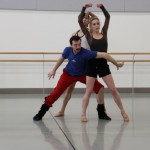 Feedback is something that’s an increasing presence in modern working life. Whilst there are well documented challenges regarding the delivery of feedback, especially if it’s critical, there are particular issues around the communication of feedback on creative projects.
Feedback is something that’s an increasing presence in modern working life. Whilst there are well documented challenges regarding the delivery of feedback, especially if it’s critical, there are particular issues around the communication of feedback on creative projects.
If you think of most work based projects, there is often a clear outcome against which to judge performance. In creative projects however, you often have little idea how things are supposed to pan out. How can you guide people when you’re unsure quite how things need to work out?
That was the quandary that a recent study set out to explore. The researchers monitored both a modern dance troupe and designers from a R&D department to understand how feedback nurtures the creative process.
With two years worth of data, consisting of interviews, focus groups and recordings, the researchers managed to uncover a number of common themes in the way feedback was given.
The criteria for successful feedback
Successful feedback would often require the creator sharing work that was incomplete for instance. It would also require two way and constructive conversations, with an appreciation that both parties are working together to get the project done.
“It blows apart this myth that for decades, people kind of assumed, ‘Well, if you’re going to be creative, you need to brainstorm’ and one of the rules of brainstorming is you don’t judge, you don’t criticize, you don’t provide feedback basically,” the authors say. “And so people have created in some ways a false aversion to the relationship between feedback and creativity. If you want someone to be creative, the myth is you just leave that person alone, that person will figure it out on their own, and when it’s ready, that person will bring you a finished iPhone or a finished whatever the next great product is. The reality is that creative people actually want people to provide input on their ideas – they just want it done in the right way, in a safe environment, in a way that honors what they’ve done in the past.”
Whilst it might seem counter-intuitive to open up incomplete work to feedback and potential ridicule, this was very common in creative work because there was a shared understanding that the idea needed to evolve.
Feedback starts with understanding
The first task is for the feedback giver to try and understand the world of the creative. They need to know exactly what it is they’re trying to do, and the journey they’ve already gone down.
It’s often at this moment, where a number of deadends have already been experienced, where the creative person is open for some feedback as to what new direction they could explore.
“A lot of feedback isn’t ‘This is what you should do,’ it’s actually ‘Where have you been? Where are you going?’ and really trying to figure out what people have been thinking about before you ever showed up to assess what it is they are working on,” the authors say.
So it’s more about providing some possible options rather than hard and fast solutions. Open ended suggestions versus closed off answers.
The authors believe that this style of feedback could also have uses in less creative areas of corporate life, especially when the tasks involve some form of innovative thinking.
The study highlights how feedback and creativity both involve change in some way, and so utilization of the kind of review meetings that are often in-built in creative endeavors can be an invaluable process.
With innovation something that is increasingly sought after in our organizations, the study hopefully has some good lessons for us all, and is well worth a read.
It's a good point. I mean we assume when we make plans that things will remain static and the conditions we devise the plan in will remain the same when things are being carried out. That's unlikely to be the case, so you have to be adaptive don't you?
Indeed, flexibility really is key.